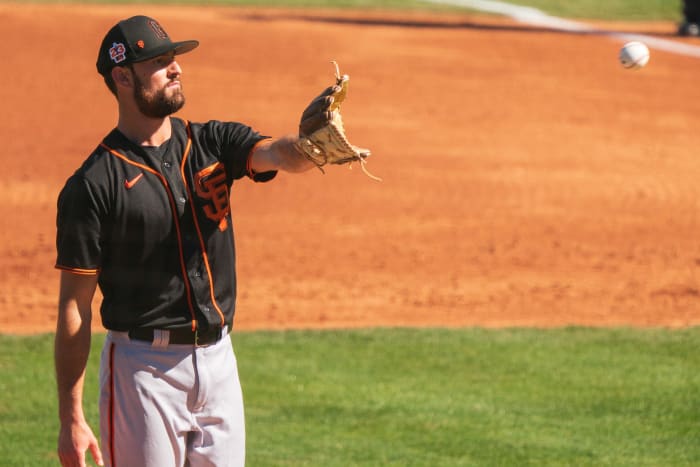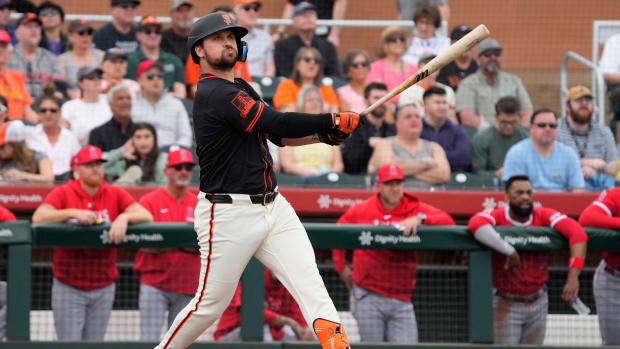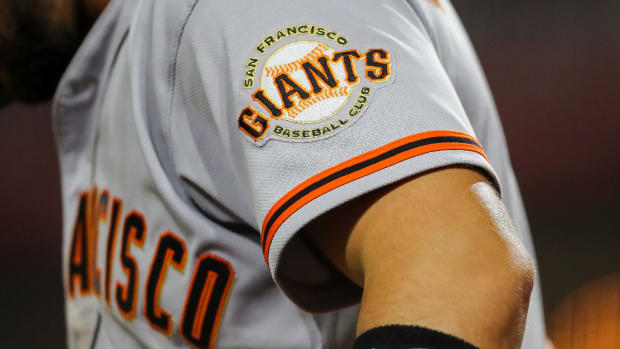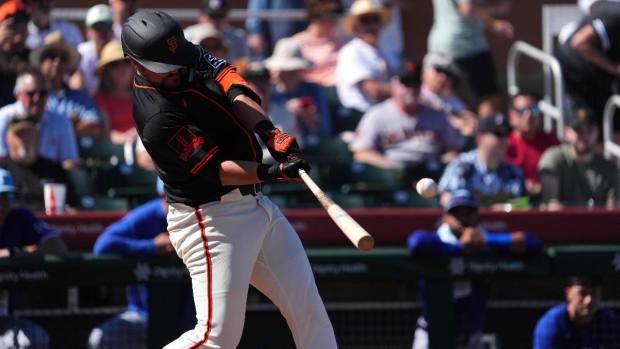SF Giants prospects weekly recap: Triple-A gets started
Welcome to the weekly SF Giants prospect recap, where we take a look at the organization's prospects and minor leaguers who stood out. Since it is Opening Week, we are only have the opening series for the Sacramento River Cats (Triple-A). With the power of Statcast and the number of prospects on the roster, this team shall be fascinating to follow throughout this season.
Before reading, be sure to check out our top 42 prospects ranking to get acclimated to players throughout the season.

Brewers shortstop Eddy Alvarez dodges a tag by SF Giants third baseman Casey Schmitt in the third inning during a Spring Training game at Scottsdale Stadium. (2023)
Matt Kartozian-USA TODAY Sports
SF Giants hitting prospects weekly recap:
On the hitters' side, let's start off with Casey Schmitt (Giants #3 prospect). The number three prospect, unsurprisingly was sent to Sacramento at the end of spring training to continue to get reps as he prepares to take the next step to become a big leaguer. The biggest reason Schmitt is still in the minors is his struggles against breaking balls.
This opening series against Salt Lake is an indication of things to come. Outside of his at-bat against Aaron Hernandez, who is mainly a fastball pitcher, only nine out of 37 pitches were categorized as fastballs. Out of the 28 offspeed pitches, he swung and missed only five times. On the other hand, three of his four hits came from offspeed pitches. The book on Schmitt so far is that you can get him with a good offspeed pitch, but he has shown the ability to hit bad offspeed pitches hard.
The second reason for Schmitt's demotion is the rather concerning 15:1 K/BB ratio in 49 plate appearances this spring. That must improve but based on what he's done this spring and in the opening series, hitting hittable pitches hard is as good as taking a walk and missing the opportunity to do damage. After three games, he already has four strikeouts in 12 plate appearances with no walks. It is something that we will continue to monitor as the season progresses.
It is now time to talk about Heliot Ramos (Giants #12 prospect). The biggest thing that Ramos has to improve entering this season is to pull and lift the ball more. After the first series, Ramos has lifted the ball twice but has hit it mostly to the opposite field. Unfortunately, all of his batted balls with an exit velocity above 100 mph have been groundballs and only one to his pull side. The jury is still out if Heliot's hitting approach and swing have changed, but if it is still the same story as last season, the chances of him making the big leagues without a significant performance improvement will remain slim.
Other Hitters of Note: Will Wilson has hit the ball well in the first series so far with four batted balls above 93 mph exit velocity but the results have not been there for him so far with just one hit. Ricardo Genovés and Michael Gigliotti looked good physically and Genovés was 2-for-3 in the first series.

SF Giants pitcher Tristan Beck on the mound during a spring training game against the Cubs. (2023)
Allan Henry-USA TODAY Sports
SF Giants pitching prospects weekly recap:
Tristan Beck (Giants #19 prospect) got the call to pitch in the first game of the season and was decent overall with 3.1 innings of two-run ball with four walks and three strikeouts. Beck follows the current pitching philosophy within the organization with 33 of his 71 pitches being the slider. Beck's slider is an above-average pitch that helps cover his fringy fastball. Even though Beck struggled with his control, he still generated whiffs with a 42% rate. Expect the same pitch usage with Beck throughout the season, but the control should be better.
With the Giants holding out Kyle Harrison (Giants #1 prospect) until the home opener, both of the remaining games were bullpen days. Ryan Walker was solid with two strikeouts in 1.2 innings scoreless innings with six whiffs. It was business as usual for him with his east-west approach. Cole Waites (Giants #26 prospect) was back to his usual ways pumping 96 mph fastballs at the top of the zone with elite IVB numbers to register his first save of the year. Expect more saves and a higher velocity once the weather warms up.
Melvin Adon is continuing to make himself relevant by pumping 97 mph sinkers and 88 mph sliders. R.J. Dabovich's (Giants #16 prospect) pitch movement plot shows that his fastball and curveball are nearly vertical to each other with the curve flashing screwball-like, arm-side movement. His fastball's vertical break is similar to Waites' while he can still pump his curveball up to 87 mph.
To wrap it up, let's talk about one more reliever in better detail. It is the first time that we have seen Kade McClure. The pitcher who came from the White Sox in the Gregory Santos trade, McClure will be an interesting case study as he is as open to learning and implementing what the coaching staff wants him to do. Based on the Statcast data, McClure throws a fastball and a curveball. The fastball data looks erratic with a 4 mph velocity difference, but it is mostly a pitch with some sink and arm-side run. His 80 mph curveball shall be his feature pitch with good depth. We will follow his progress as the season goes on as a ball of clay that is willing to be molded.





